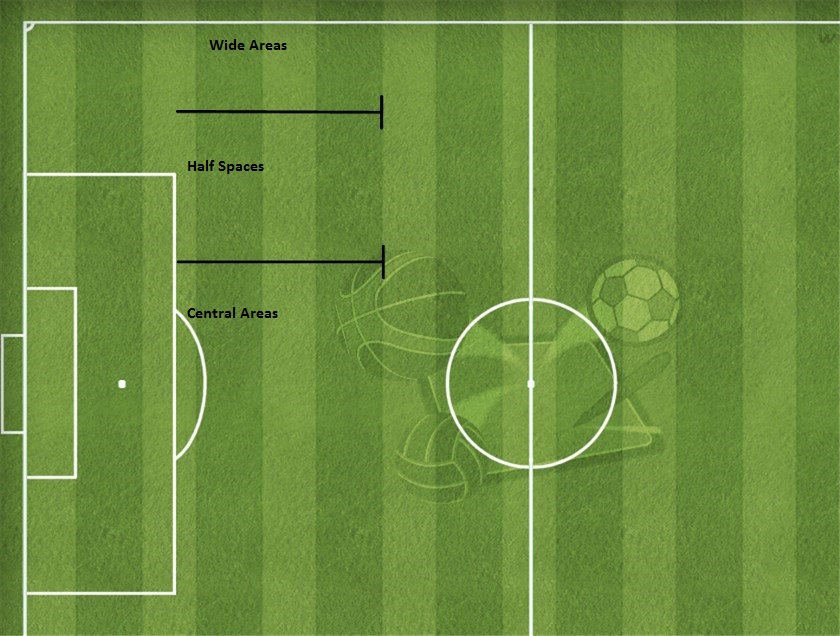Writing in the half spaces
‘Half spaces’ is a relatively new football term. It refers to the areas between the side of the pitch and the centre:

These are hard to cover because the defensive team is usually set up to stop opposing forwards on the wings and in the middle. If an attacker runs into the half space the defenders can’t be sure whose job it is to stop him.
I think good writing happens in half spaces; areas where the reader isn’t expecting you to appear, so they don’t have their defences up. We’re all attuned to the approach paths of clichés and tropes, so we’re fully prepared to repel their sorry arses, casting eye-rolls in their direction as we bat them away.
Therefore, to retain the element of surprise, we must head to the half spaces!
Writing half spaces come in many shapes and sizes. Structurally, they can appear as plot twists or unusual situations. In terms of form, they can exist in breaking the fourth wall, writing the story through a new medium, such as emails or text messages, or creating a story within a story within a story.
But I want to talk about the smaller half spaces. With a bit of perspective you can create them inside a single sentence, and certainly within a 30-second ad.
I’ll start with a minor fascination of mine. I’m not sure it has a name, so I’m going to call it the redundant elongation. When you talk about those red things you stick together to make a building you tend to use the word ‘brick’. The thing in the corner of a letter is usually a ‘stamp’, and that thing people drive is generally referred to as a car. But they can also be called a ‘house brick’, a ‘postage stamp’ and a ‘motorcar’. Is there a good reason to use a longer word with an identical meaning? No, and that’s the point. It makes the word stick out a little and prevents the prose from becoming wallpaper. It could also give a character subtle colour, or help the rhythm of a line. So it gets to live in the half space: grenade or hand grenade? Boat or sailboat? Worm or earthworm?
Another one is the anti-cliché. I once wrote an Economist poster that asked, ‘What exactly is the benefit of the doubt?’. I took a cliché and turned it into the opposite of itself: something unfamiliar to give the reader pause. My colleagues did something similar with ‘Carpe annum’ and ‘Think someone under the table’.
But so did Radiohead, in their own special way. Listen to the lyrics of You And Whose Army?, which takes that cliché and twists it into an insecure whinge. And A Wolf At The Door (another cliché) uses ‘Take it with a pinch of salt’ in a long list of sardonic bullshit. Even Robbie Williams reprogrammed ‘Come and have a go if you think you’re hard enough’ in Millennium.
But the real half spaces are the insights that make all good art. Sure you can go deep into the human condition for a Dark Side Of The Moon or Great Expectations, but smaller moments of recognition can be just as powerful because they make us feel connected in a more quotidian way:
The terror of sleeves inching their way down your forearms as you wash your hands.
Why does clingfilm stretch when you want it to tear and vice versa?
What do you do in the no man’s land between a person being close enough for you to hold the door open for them, and the point when they’re a little too far away?
The tingling sensation you get after pins and needles is oddly similar to what happens to your tongue when you lick the end of a 9-volt battery. Are they related?
Why do smoke detector batteries only run out at 4am?
The odd feeling you get when you expect there to be another step at the top of a staircase.
True happiness comes from listening to music in the car and arriving at your destination exactly as the song is ending.
Etc.
So look to the half spaces. Sneak up on your reader, viewer or listener and give them a touch of surprise and delight, one they may not even appreciate till much later. That’s the kind of stuff we like to consume, so that should be the kind of stuff you like to create.
Be the dude playing the dude who thinks he’s the dude.
Brilliant. A genuinely useful and enjoyable read that sneaked in amongst the quagmire of drivel.
Nigel, praise from you in the area of writing is better than any award.
Thanks.